This is an old revision of this page, as edited by Fənɛ́tɪks.fərɛvər (talk | contribs) at 11:15, 24 January 2014 (direct link to George, updated HDR link (from 2010 >2013), checked sources, added dates in the first paragraphs. Added full stops, added currencies in Europe, developed the 'currencies' section). The present address (URL) is a permanent link to this revision, which may differ significantly from the current revision.
Revision as of 11:15, 24 January 2014 by Fənɛ́tɪks.fərɛvər (talk | contribs) (direct link to George, updated HDR link (from 2010 >2013), checked sources, added dates in the first paragraphs. Added full stops, added currencies in Europe, developed the 'currencies' section)(diff) ← Previous revision | Latest revision (diff) | Newer revision → (diff)



Central Europe or alternatively Middle Europe is a region of the European continent lying between the variously defined areas of Eastern and Western Europe. The term and widespread interest in the region came back with the regeneration and gentrification of the region since 1989, the end of the Cold War, which had divided Europe politically into the Eastern Bloc and the Western Bloc, splitting Central Europe in half for 45 years.
The concept of Central Europe, and that of a common identity, is somewhat elusive. However, scholars assert that a distinct "Central European culture, as controversial and debated the notion may be, exists." It is based on "similarities emanating from historical, social and cultural characteristics", and it is identified as having been "one of the world's richest sources of creative talent" between the 17th and 20th centuries. Cross Currents: A Yearbook of Central European Culture characterizes Central Europe "as an abandoned West or a place where East and West collide". Germany's Constant Committee for Geographical Names defines Central Europe both as a distinct cultural area and a political region. George Schöpflin and others argue that Central Europe is defined by being "a part of Western Christianity", while Samuel P. Huntington places the region firmly within Western culture.
From the 1989 (decade) on, with initiatives like the CEI (1989), V4 (1993) or Centrope (2003), Central Europe is going through a phase of "strategic awakening", . While the region's economy shows high disparities with regard to income, all Central European countries are listed by the Human Development Index as "very high development" countries.
Countries
The comprehension of the concept of Central Europe is an ongoing source of controversy, though the Visegrád Group constituents are generally included as de facto C.E. countries.
Countries classified as Central European
According to the majority of sources (see section Current views on Central Europe for some) the region includes:
 Austria
Austria Czech Republic
Czech Republic Germany
Germany Hungary
Hungary Liechtenstein
Liechtenstein Poland
Poland Slovakia
Slovakia Slovenia typically placed in Central Europe, or sometimes in Southeastern Europe
Slovenia typically placed in Central Europe, or sometimes in Southeastern Europe Switzerland
Switzerland
Countries (regions) occasionally included in Central Europe
Some sources also add neighbouring countries for historical (the former Austro-Hungarian and German Empires, and modern Baltic states), based on geographical and/or cultural reasons:
 Croatia alternatively it is placed in Southeastern Europe.
Croatia alternatively it is placed in Southeastern Europe. Romania
Romania Serbia (Vojvodina, Mačva and Belgrade historically also Sandžak, Šumadija and Braničevo, and at various times Central Serbia)
Serbia (Vojvodina, Mačva and Belgrade historically also Sandžak, Šumadija and Braničevo, and at various times Central Serbia)
The Baltic states, geographically located in Northern Europe, have been considered part of Central Europe in the German tradition of the term, Mittleuropa.
Benelux countries are generally considered a part of Western Europe, rather than Central Europe. Nevertheless, they are occasionally mentioned i the Central European context due to cultural, historical and linguistic ties.
Smaller parts of the following states may sometimes be included:
 Ukraine (West Ukraine)
Ukraine (West Ukraine) Belarus (West Belarus)
Belarus (West Belarus) Russia (Kaliningrad Oblast)
Russia (Kaliningrad Oblast) France (Alsace and portions of Lorraine)
France (Alsace and portions of Lorraine) Italy (South Tyrol, Trentino, Trieste and Gorizia, Friuli, occasionally all of Northern Italy)
Italy (South Tyrol, Trentino, Trieste and Gorizia, Friuli, occasionally all of Northern Italy) Romania (Transylvania and Southern Bukovina)
Romania (Transylvania and Southern Bukovina) Serbia (Vojvodina, Mačva and Belgrade historically also Sandžak, Šumadija and Braničevo, and at various times Central Serbia)
Serbia (Vojvodina, Mačva and Belgrade historically also Sandžak, Šumadija and Braničevo, and at various times Central Serbia)
General data
- Area: 1.036.370 km (2012)

- Population: (calculated data) 163.518.571 (July 2012)

- Population Density: (calculated data) 157.78/km (2012)

- GDP (PPP) per capita: USD $34.444 (2012)

- Life expectancy: (calculated data) 78.32-year (2012)

- Unemployment rate: 8.2% (2012)

- Fertility rate: 1.41 births/woman (2012)

- Human Development Index: 0.874 (2012) (very high)

- Globalization Index (regional): 80.09 (2013)

Economy
Industrialisation reached Central Europe early: Luxembourg and Germany by 1860, the Czech Republic, Poland, Slovakia and Switzerland by 1870, Austria, Croatia, Hungary, Liechtenstein, Romania, Serbia and Slovenia by 1880. Depending on a definition of, most of these countries are considered developed. Countries with 'Very high' score in HDI, OECD membership, IMF's 'Advanced Economies', DAC membership and WB's 'High income economies':
'Very high' score in HDI, OECD membership, DAC membership and WB's 'High income economies':
'Very high' score in HDI, DAC membership and WB's 'High income economies':
Countries with 'Very high' score in HDI and OECD membership:
'Very high' score in HDI:
'High' score in HDI:
Gross Domestic Product
Nominal

Central European countries are generally wealthy in terms of nominal GDP (in millions, 2012):
 Germany: 3,425,956 US$ (4th)
Germany: 3,425,956 US$ (4th) Switzerland: 631,183 US$ (20th)
Switzerland: 631,183 US$ (20th) Poland: 489,852 US$ (24th)
Poland: 489,852 US$ (24th) Austria: 394,458 US$ (27th)
Austria: 394,458 US$ (27th) Czech Republic: 196,446 US$ (49th)
Czech Republic: 196,446 US$ (49th) Romania: 169,396 US$ (54th)
Romania: 169,396 US$ (54th) Hungary: 124,600 US$ (58th)
Hungary: 124,600 US$ (58th) Slovakia: 91,349 (62nd)
Slovakia: 91,349 (62nd) Croatia: 56,447 US$ (71st)
Croatia: 56,447 US$ (71st) Luxembourg: 55,143 US$ (72nd)
Luxembourg: 55,143 US$ (72nd) Slovenia: 45,380 US$ (79th)
Slovenia: 45,380 US$ (79th) Serbia: 38,491 US$ (87th)
Serbia: 38,491 US$ (87th) Liechtenstein: 5,827 US$ (147th)
Liechtenstein: 5,827 US$ (147th)
Purchasing Power Parity
Countries in Central Europe have generally much different GDP purchasing power parity when compared to the nominal GDP (in trillions, World Bank, 2012):
 Germany: 3,349 US$ (6th)
Germany: 3,349 US$ (6th) Poland: 854 US$ (18th)
Poland: 854 US$ (18th) Switzerland: 427 US$ (31st)
Switzerland: 427 US$ (31st) Austria: 374 US$ (37th)
Austria: 374 US$ (37th) Romania: 352 US$ (38th)
Romania: 352 US$ (38th) Czech Republic: 280 US$ (47th)
Czech Republic: 280 US$ (47th) Hungary: 220 US$ (52nd)
Hungary: 220 US$ (52nd) Slovakia: 137 US$ (62nd)
Slovakia: 137 US$ (62nd) Croatia: 88 US$ (73rd)
Croatia: 88 US$ (73rd) Serbia: 83 US$ (74th)
Serbia: 83 US$ (74th) Slovenia: 57 US$ (85th)
Slovenia: 57 US$ (85th) Luxembourg: 48.6 US$ (92nd)
Luxembourg: 48.6 US$ (92nd) Liechtenstein: 3.2 US$ (168th) in 2009 (CIA)
Liechtenstein: 3.2 US$ (168th) in 2009 (CIA)
Nominal per capita
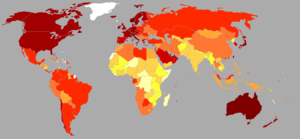
| over $102,400 $51,200–102,400 $25,600–51,200 $12,800–25,600 $6,400–12,800 $3,200–6,400 | $1,600–3,200 $800–1,600 $400–800 below $400 unavailable |
Gross domestic product (nominal) in GDP varies in central Europe from middle to high (UN, 2012):
 Liechtenstein: 158,977 US$ (1st)
Liechtenstein: 158,977 US$ (1st) Luxembourg: 105,287 US$ (3rd)
Luxembourg: 105,287 US$ (3rd) Switzerland: 78,924 US$ (6th)
Switzerland: 78,924 US$ (6th) Austria: 46,604 US$ (16th)
Austria: 46,604 US$ (16th) Germany: 41,376 US$ (23rd)
Germany: 41,376 US$ (23rd) Slovenia: 21,947 US$ (38th)
Slovenia: 21,947 US$ (38th) Czech Republic: 18,428 US$ (43rd)
Czech Republic: 18,428 US$ (43rd) Slovakia: 16,774 US$ (46th)
Slovakia: 16,774 US$ (46th) Croatia: 13,105 US$ (57th)
Croatia: 13,105 US$ (57th) Poland: 12,820 US$ (58th)
Poland: 12,820 US$ (58th) Hungary: 12,490 US$ (60th)
Hungary: 12,490 US$ (60th) Romania: 7,787 US$ (75th)
Romania: 7,787 US$ (75th) Serbia: 5,315 US$ (100th)
Serbia: 5,315 US$ (100th)
PPP per capita

Gross Domestic Power demonstrates that some Central European countries tend to have either much lower or higher rate of GDP in purchasing power parity (World Bank, 2012):
 Liechtenstein 89,400 Int$ (not ranked), according to the CIA (2009)
Liechtenstein 89,400 Int$ (not ranked), according to the CIA (2009) Luxembourg: 91,388 Int$ (1st)
Luxembourg: 91,388 Int$ (1st) Switzerland: 53,367 Int$ (5th)
Switzerland: 53,367 Int$ (5th) Austria: 44,208 Int$ (10th)
Austria: 44,208 Int$ (10th) Germany: 40,901 Int$ (17th)
Germany: 40,901 Int$ (17th) Slovenia: 27,475 Int$ (34th)
Slovenia: 27,475 Int$ (34th) Czech Republic: 26,590 Int$ (37th)
Czech Republic: 26,590 Int$ (37th) Slovakia: 25,300 Int$ (41st)
Slovakia: 25,300 Int$ (41st) Poland: 22,162 Int$ (47th)
Poland: 22,162 Int$ (47th) Hungary: 22,119 Int$ (48th)
Hungary: 22,119 Int$ (48th) Croatia: 20,532 Int$ (50th)
Croatia: 20,532 Int$ (50th) Romania: 16,518 Int$ (60th)
Romania: 16,518 Int$ (60th) Serbia: 11,544 Int$ (76th)
Serbia: 11,544 Int$ (76th)
Gini coefficient

Central Europe is generally characterised by a low wealth inequality. The countries with lowest GINI inequality rate: Slovenia, the Czech Republic, Slovakia, Luxembourg, Romania, Hungary, Poland and Germany. The rate in Switzerland is 4th highest in the world.
Currencies
Main article: List of currencies in EuropeCurrently, the members of the Eurozone include: Austria, Germany, Luxembourg, Slovakia and Slovenia. Croatia, the Czech Republic, Hungary, Poland and Romania use their currencies but are obliged to adopt the Euro:
- Croatian kuna (HRK: 1 kn = 100 lipa)
- Czech koruna (CZK: 1 Kč = haléř)
- Hungarian forint (HUF: 1 Ft = fillér )
- Polish złoty (PLN: 1 zł = 100 grosz)
- Romanian leu (RON: 1 lei = 100 ban)
Liechtenstein, Serbia and Switzerland use their own currencies:
- Serbian dinar (RSD or РСД: RSD/РСД = 100 para)
- Swiss franc (Liechtenstein and Switzerland) (CHF: 1 CHF = 100 Rap/centime/ centesimo)
Human Development Index

| Very High | Low |
| High | Data unavailable |
| Medium |
Countries in descending order of the Human Development Index (2013 data):
 Germany: 0.920 (ranked 5)
Germany: 0.920 (ranked 5) Switzerland: 0.913 (ranked 9)
Switzerland: 0.913 (ranked 9) Austria: 0.895 (ranked 18)
Austria: 0.895 (ranked 18) Slovenia: 0.892 (ranked 21)
Slovenia: 0.892 (ranked 21) Liechtenstein: 0.883 (ranked 24)
Liechtenstein: 0.883 (ranked 24) Luxembourg: 0.875 (ranked 24)
Luxembourg: 0.875 (ranked 24) Czech Republic: 0.873 (ranked 28)
Czech Republic: 0.873 (ranked 28) Slovakia: 0.840 (ranked 35)
Slovakia: 0.840 (ranked 35) Hungary: 0.831 (ranked 37)
Hungary: 0.831 (ranked 37) Poland: 0.821 (ranked 39)
Poland: 0.821 (ranked 39) Croatia: 0.805 (ranked 47)
Croatia: 0.805 (ranked 47) Romania: 0.786 (ranked 47)
Romania: 0.786 (ranked 47) Serbia: 0.769 (ranked 60)
Serbia: 0.769 (ranked 60)
Globalisation

The index of globalization of Central European countries (2013 data)
 Austria: 89.48 (ranked 4)
Austria: 89.48 (ranked 4) Hungary: 86.85 (ranked 9)
Hungary: 86.85 (ranked 9) Switzerland: 86.28 (ranked 10)
Switzerland: 86.28 (ranked 10) Czech Republic: 84.86 (ranked 15)
Czech Republic: 84.86 (ranked 15) Slovakia: 83.49 (ranked 19)
Slovakia: 83.49 (ranked 19) Germany: 81.08 (ranked 22)
Germany: 81.08 (ranked 22) Poland: 79.10 (ranked 26)
Poland: 79.10 (ranked 26) Slovenia: 76.85 (ranked 30)
Slovenia: 76.85 (ranked 30) Croatia: 75.88 (ranked 31)
Croatia: 75.88 (ranked 31) Romania: 72.53 (ranked 38)
Romania: 72.53 (ranked 38) Serbia: 64.90 (ranked 53)
Serbia: 64.90 (ranked 53) Liechtenstein: 52.88 (not officially ranked: 101)
Liechtenstein: 52.88 (not officially ranked: 101)
Innovation
In the Bloomberg Innovation Index ranking 50 most innovative countries, most countries in Central Europe were mentioned:
 Germany (ranked 5th)
Germany (ranked 5th) Switzerland (ranked 8th)
Switzerland (ranked 8th) Austria (ranked 17th)
Austria (ranked 17th) Luxembourg (ranked 21st)
Luxembourg (ranked 21st) Czech Republic (ranked 23rd)
Czech Republic (ranked 23rd) Poland (ranked 24th)
Poland (ranked 24th) Hungary (ranked 26th)
Hungary (ranked 26th) Slovenia (ranked 31st)
Slovenia (ranked 31st) Romania (ranked 37th)
Romania (ranked 37th) Croatia (ranked 43rd)
Croatia (ranked 43rd) Slovakia (ranked 46th)
Slovakia (ranked 46th) Liechtenstein (not ranked amongst top 50 countries)
Liechtenstein (not ranked amongst top 50 countries) Serbia (not ranked amongst top 50 countries)
Serbia (not ranked amongst top 50 countries)
Prosperity Index
Legatum Prosperity Index demonstrates an average to a high level of prosperity in Central Europe:
 Switzerland (ranked 2)
Switzerland (ranked 2) Luxembourg (ranked 10)
Luxembourg (ranked 10) Germany (ranked 14)
Germany (ranked 14) Austria (ranked 15)
Austria (ranked 15) Czech Republic (ranked 24)
Czech Republic (ranked 24) Slovenia (ranked 29)
Slovenia (ranked 29) Poland (ranked 34)
Poland (ranked 34) Slovakia (ranked 38)
Slovakia (ranked 38) Hungary (ranked 41)
Hungary (ranked 41) Croatia (ranked 53)
Croatia (ranked 53) Romania (ranked 55)
Romania (ranked 55) Serbia (ranked 76)
Serbia (ranked 76)
Corruption
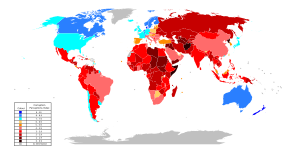
| 90–100 | 60–69 | 30–39 | 0–9 |
| 80–89 | 50–59 | 20–29 | No information |
| 70–79 | 40–49 | 10–19 |
Most countries in Central Europe score tend to score above the average in the Corruption Perceptions Index:
 Switzerland (ranked 7)
Switzerland (ranked 7) Luxembourg (ranked 11)
Luxembourg (ranked 11) Germany (ranked 12)
Germany (ranked 12) Austria (ranked 26)
Austria (ranked 26) Poland (ranked 38)
Poland (ranked 38) Slovenia (ranked 43)
Slovenia (ranked 43) Hungary (ranked 47)
Hungary (ranked 47) Croatia (ranked 57=)
Croatia (ranked 57=) Czech Republic (ranked 57=)
Czech Republic (ranked 57=) Slovakia (ranked 61)
Slovakia (ranked 61) Romania (ranked 69)
Romania (ranked 69) Serbia (ranked 72)
Serbia (ranked 72) Liechtenstein (not ranked)
Liechtenstein (not ranked)
According to the Bribe Payers Index, released annually since 1995 by the Berlin-based NGO Transparency International, Germany and Switzerland (the only two Central European countries examined in the study) were ranked respectively 2nd and 4th in 2011.
Infrastructure
Industrialisation reached Central Europe very early. That caused construction of rail and other types of infrastructure.
Rail

The use of began with the opening of the steam-hauled Bavarian Ludwig Railway between Nuremberg and Fürth on 7 December 1835. This event opened a wide introduction of the technology in the part of Europe. The rail infrastructure is Central Europe is very dense. Railway density, with total length of lines operated (km) per 1000 km2, is much higher in the Czech Republic (198.6), Poland (121.0), Slovenia (108.0), Germany (105.5), Hungary (98.7), Romania (85.9), Slovakia (73.9), Croatia (72.5) and Serbia (43.1), then the average in Europe and the rest of the world.
Branches

This list orders countries by their economic complexity index (ECI), as it was defined and calculated by Ricardo Hausmann, Cesar Hidalgo and other contributors based mainly at the Harvard-MIT Observatory of Economic Complexity.
Compared to most of Europe, the economies of Germany, Switzerland, Austria, Czech Republic, Slovenia, Hungary, the Slovak Republic, Poland, Croatia and Romania tend to demonstrate high complexity. The ranking includes:
 Germany (2nd)
Germany (2nd) Switzerland (3rd)
Switzerland (3rd) Austria (5th)
Austria (5th) Czech Republic (8th)
Czech Republic (8th) Slovenia (10th)
Slovenia (10th) Hungary (14th)
Hungary (14th) Slovakia (15th)
Slovakia (15th) Poland (25th)
Poland (25th) Croatia (26th)
Croatia (26th) Romania (27th)
Romania (27th) Serbia (37th)
Serbia (37th) Liechtenstein (not ranked)
Liechtenstein (not ranked) Luxembourg (not ranked)
Luxembourg (not ranked)
Agriculture
Central European countries are some of the most significant food producers in the world. The Czech Republic is world's 4th largest hops producer and 8th producer of triticale. Germany is the world's largest hops producer, 3rd producer of rye and barley, 5th rapeseed producer, 6th largest milk producer, 5th largest potato producer. Hungary is world's 5th hops and 7th largest triticale producer. Poland is the world's largest triticale producer, second largest producer of raspberry, currant and rye, 3rd largest, 5th apple and buckwheat producer, 7th largest potatoes producer. Slovenia is world's 6th hops producer.
Tourism
Switzerland, Germany, Austria and Luxembourg are some of the most competitive tourism destinations.
Outsourcing destination
Kraków, Prague, Budapest, Brno, Warsaw, Bucharest, Bratislava, Wroclaw, Ljubljana, Lviv and Zagreb are amongst top 100 outsourcing destinations. Poland is currently a major destination for outsourcing business services.
Human rights
Main article: Human rights in EuropeCentral European countries generally have a good record on human rights, with a long-standing history. Golden Bull of 1222 of Hungary defines the first time the rights of citizens (however, limited to gentry), the General Charter of Jewish Liberties (Statute of Kalisz) introduced numerous right for the Jews in Poland, leading to an autonomous "nation within a nation", and Warsaw Confederation confirmed the religious freedom of all residents of Poland In 1781, Serfdom is abolished in the Habsburg countries through the emperor Leopold II. Countries in Central Europe have either medium of low risk of human rights risk.
Children
Main article: Children's rights
Corporal punishment is either prohibited or considered a criminal offence in most of Central Europe's countries, in all settings (school and home):
 Poland (in schools since 1783 and unlawful since 1964, since 2010 criminalised in all of its forms)
Poland (in schools since 1783 and unlawful since 1964, since 2010 criminalised in all of its forms) Liechtenstein (in the home 1811, illegal since 1985, explicitly criminalised in all forms since 2008)
Liechtenstein (in the home 1811, illegal since 1985, explicitly criminalised in all forms since 2008) Luxembourg (since 1845 prohibited in schools and since 2008 in all its forms)
Luxembourg (since 1845 prohibited in schools and since 2008 in all its forms) Romania (in schools prohibited since 1948 and unlawful since 1991, since 2004 forbidden in all its forms)
Romania (in schools prohibited since 1948 and unlawful since 1991, since 2004 forbidden in all its forms) Austria (in schools banned since 1974, since 1989 in all of its forms)
Austria (in schools banned since 1974, since 1989 in all of its forms) Germany (in schools banned gradually in the period 1975-1983, since 2000 in all of its forms)
Germany (in schools banned gradually in the period 1975-1983, since 2000 in all of its forms) Hungary (in schools prohibited since 1993, since 2004 illegal in all its forms)
Hungary (in schools prohibited since 1993, since 2004 illegal in all its forms) Croatia (since 1999 prohibited in schools and since 2003 in the home)
Croatia (since 1999 prohibited in schools and since 2003 in the home) Slovenia (in schools prohibited since 1996 and in the home since 2008)
Slovenia (in schools prohibited since 1996 and in the home since 2008)
Laws partially banning or outlawing corporal punishments have been introduced in the following countries:
 Serbia (in schools prohibited since 1929 and criminalised since 1992)
Serbia (in schools prohibited since 1929 and criminalised since 1992) Switzerland (in schools unlawful since 1993)
Switzerland (in schools unlawful since 1993) Slovakia (in schools prohibited since 2008)
Slovakia (in schools prohibited since 2008) Czech Republic (no full ban, partly prohibited in the home since 2014)
Czech Republic (no full ban, partly prohibited in the home since 2014)
Civil rights
Main article: Civil rightsAll countries in Central Europe are ranked 'free', according to the Freedom in the World reports.
Death penalty
Capital punishment, as an irrevocable punishment prone to miscarriage of justice and degrading treatment of a human being, has been formally abolished in all countries of Central Europe for all offences by 2006.
LGBT
Main article: LGBT rights by country or territoryLGBT people in Central Europe may face legal challenges not experienced by non-LGBT residents. All of the countries of the region have signed the LGBT rights Declaration, rights of heterosexual citizens are unavailable to LGBT people. None of Central European countries is on the list of countries with state-sponsored homophobia. Some of the prominent living people in Central Europe are gay: Ulrike Lunacek (Austria), Guido Westerwelle (Germany), Xavier Bettel (Luxembourg) and Robert Biedroń (Poland). Homosexuality is legal in all countries of Central Europe (since):
 Poland (never criminalised under Polish jurisdiction, and confirmed legal in 1932)
Poland (never criminalised under Polish jurisdiction, and confirmed legal in 1932) Luxembourg (1794)
Luxembourg (1794) Switzerland (1942)
Switzerland (1942) Czech Republic (1961)
Czech Republic (1961) Slovakia (1961)
Slovakia (1961) Hungary (1961)
Hungary (1961) Germany (1967-68 in all Germany)
Germany (1967-68 in all Germany) Austria (1971)
Austria (1971) Croatia (1977)
Croatia (1977) Slovenia (1977)
Slovenia (1977) Liechtenstein (1989)
Liechtenstein (1989) Serbia (1994)
Serbia (1994) Romania (1996)
Romania (1996)
Transgender rights are very well-developed in some countries of Central Europe. A transgender Pole Anna Grodzka has become an MP in the 2011 Polish parliamentary elections.
 Austria,
Austria,  Germany,
Germany,  Hungary and
Hungary and  Poland - recognise gender change and require no sterilisation
Poland - recognise gender change and require no sterilisation Croatia,
Croatia,  Czech Republic,
Czech Republic,  Luxembourg,
Luxembourg,  Romania,
Romania,  Slovakia and
Slovakia and  Switzerland - recognise gender change, but require sterilisation
Switzerland - recognise gender change, but require sterilisation Liechtenstein,
Liechtenstein,  Serbia and
Serbia and  Slovenia have no gender recognition
Slovenia have no gender recognition
There has been cases of hate crime assaults on transgender people or harassment. In the period between 2008 and 2012, 2 transgender people have been murdered in Germany, 1 person in Poland and 1 in Serbia.
Slavery

The issue of slavery was specifically addressed in:
 Germany (~1220 condemned by Sachsenspiegel, the most influential German law journal, and in 1946, slavery was first persecuted as by the procurer of forced labour during the WW2, Fritz Sauckel)
Germany (~1220 condemned by Sachsenspiegel, the most influential German law journal, and in 1946, slavery was first persecuted as by the procurer of forced labour during the WW2, Fritz Sauckel) Poland (banned since 1588)
Poland (banned since 1588) Serbia (since 1835, yet there are claims that slavery did not exist in Serbia, except the Ottoman occupation)
Serbia (since 1835, yet there are claims that slavery did not exist in Serbia, except the Ottoman occupation)
According to the Walk Free Foundation, modern slavery, defined as: "the possession and control of a person in such a way as to significantly deprive that person of his or her individual liberty, with the intent of exploiting that person through their use, management, profit, transfer or disposal. Usually this exercise will be achieved through means such as violence or threats of violence, deception and/or coercion." In Central Europe results showed low to medium degree of slavery. The position of countries in the degree of slavery is as following:
 Czech Republic (54th=)
Czech Republic (54th=) Hungary (54th=)
Hungary (54th=) Serbia (59th)
Serbia (59th) Croatia (61st=)
Croatia (61st=) Poland (61st=)
Poland (61st=) Slovakia (61st=)
Slovakia (61st=) Slovenia (67th)
Slovenia (67th) Romania (125th)
Romania (125th) Germany (136th)
Germany (136th) Austria (150th=)
Austria (150th=) Luxembourg (150th=)
Luxembourg (150th=) Switzerland (150th=)
Switzerland (150th=) Liechtenstein (not ranked)
Liechtenstein (not ranked)
Human trafficking
Main article: Human trafficking
The issue of human trafficking is relatively rare in Central Europe, according to the Trafficking in Persons Report (2013):
- classified as 'Tier 1' countries:
- classified as 'Tier 2' countries:
![]() Liechtenstein was not mentioned in the report.
Liechtenstein was not mentioned in the report.

Human trafficking concerns Central European women, despite illegality of it. In 2011 trafficking was:
- 'illegal and rare' in:
- 'illegal but there are performance lapses' in:
- 'illegal but is still practiced' in:
Women
Main article: Women's rightsWomen's suffrage came to most countries of Central Europe very early (when compared to the rest of the world). In Poland, prior to the Partition in 1795, tax-paying females were allowed to take part in political life:
 Poland (tax-paying women before 1795, and all women since Poland's independence in 1918)
Poland (tax-paying women before 1795, and all women since Poland's independence in 1918) Germany (1918)
Germany (1918) Hungary (1918)
Hungary (1918) Austria (1919)
Austria (1919) Luxembourg (1919)
Luxembourg (1919) Czech Republic (1920)
Czech Republic (1920) Slovakia (1920)
Slovakia (1920) Romania (1938)
Romania (1938) Croatia (1945)
Croatia (1945) Serbia (1945)
Serbia (1945) Slovenia (1945)
Slovenia (1945) Switzerland (1971)
Switzerland (1971) Liechtenstein (1984)
Liechtenstein (1984)
In spite of the advancement, there are almost no Central European women in the list of the most influential women nor the most influential people. Some of the prominent Central European women include: Angela Merkel (chancellor), Anna Walentynowicz (free union and anti-communism actvist), Herta Müller, Elfriede Jelinek (writer), Božena Němcová (writer), Maria Konopnicka (writer) and Narcyza Żmichowska (a writer and a precursor of feminism in Poland)
Education

Education is compulsory in Central European countries, generally from the age of 6 (i.e. Germany, Hungary, Slovenia) or 7 (Poland), until the age of 15 (Slovenia), 16 (Germany) or 18 (Poland). Most Central European countries have banned the corporal punishment of children in schools
Adult Lieracy
Central European countries are very literate. All of them have the literacy rate of 96% or over (for both sexes):
| Country | Literacy rate (all) | Male Literacy | Female Literacy | Criteria |
|---|---|---|---|---|
| -9e99 | -9e99 | !a | -9e99 | |
| 84.1% | 88.6% | 79.7% | age 15 and over can read and write (2010 est.) | |
| 100% | 100% | 100% | age 10 and over can read and write | |
| 100% | 100% | 100% | age 15 and over can read and write (2000 est.) | |
| 99.7% | 99.9% | 99.6% | age 15 and over can read and write (2011 est.) | |
| 99.7% | 99.7% | 99.7% | (2010 est.) | |
| 99.6% | 99.7% | 99.6% | age 15 and over can read and write (2004) | |
| 99% | 99% | 99% | (2011 est.) | |
| 99% | 99% | 99% | age 15 and over can read and write (2003 est.) | |
| 99% | 99.2% | 98.9% | age 15 and over can read and write (2011 est.) | |
| 99% | 99% | 99% | age 15 and over can read and write (2003 est.) | |
| 98.9% | 99.5% | 98.3% | age 15 and over can read and write (2011 est.) | |
| 98% | N/A | N/A | age 15 and over can read and write | |
| 98% | 99.2% | 96.9% | age 15 and over can read and write (2011 est.) | |
| 97.7% | 98.3% | 97.1% | age 15 and over can read and write (2011 est.) |
Languages
Main article: Languages of EuropeLanguages taught as the first language in Central Europe are: German, Polish, Romanian, Czech, Hungarian, Serbian, Slovenian, Croatian, Slovak and Letzemburgish. All of them (except for Hungarian) are Indo-European languages and use the Latin script(except for Serbia). The most popular language taught at schools in Central Europe as foreign languages are: English, French and German.
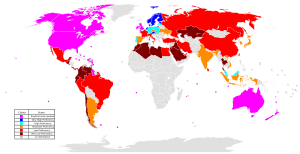
The level of proficiency in the English language is ranked es high or moderate, according to the EF English Proficiency Index:
 Austria (position 6)
Austria (position 6) Poland (position 8)
Poland (position 8) Hungary (position 9)
Hungary (position 9) Slovenia (position 10)
Slovenia (position 10) Germany (position 14)
Germany (position 14) Switzerland (position 16)
Switzerland (position 16) Slovakia (position 18)
Slovakia (position 18) Czech Republic (position 20)
Czech Republic (position 20) Croatia (not ranked)
Croatia (not ranked) Liechtenstein (not ranked)
Liechtenstein (not ranked) Luxembourg (not ranked)
Luxembourg (not ranked) Romania (not ranked)
Romania (not ranked) Serbia (not ranked)
Serbia (not ranked)
Nevertheless, other languages are also popular (spoken by over 5% as a second language):
- Croatian in Slovenia (61%)
- Czech in Slovakia (47%)
- French in Luxembourg (80%), Romania (17%), Germany (14%) and Austria (11%)
- German in Luxembourg (69%), Slovenia (42%), Slovenia (22%), Poland (20%), Hungary (18%), the Czech Republic (15%), Germany (10%) and Romania (5%)
- Italian in Slovenia (12%), Austria (9%), Romania (7%) and Luxembourg (6%)
- Russian in Poland (28%), Slovakia (17%), Czech Republic (13%) and Germany (6%)
- Polish in Slovakia (5%)
- Slovak in the Czech Republic (16%)
- Spanish in Luxembourg (5%) and Romania (5%)
Scholastic Performance
Student performance has varied across Central Europe, according to the Programme for International Student Assessment. In the last study (PISA 2012), countries scored medium, below or over the average scores in three fields studied.
In Maths:

 Liechtenstein (position 8) - above the OECD average
Liechtenstein (position 8) - above the OECD average Switzerland (position 9) - above the OECD average
Switzerland (position 9) - above the OECD average Poland (position 14) - above the OECD average
Poland (position 14) - above the OECD average Germany (position 16) - above the OECD average
Germany (position 16) - above the OECD average Austria (position 18) - above the OECD average
Austria (position 18) - above the OECD average Slovenia (position 21) - above the OECD average
Slovenia (position 21) - above the OECD average Czech Republic (position 24) - similar to the OECD average
Czech Republic (position 24) - similar to the OECD average Luxembourg (position 29) - below the OECD average
Luxembourg (position 29) - below the OECD average Slovakia (position 35) - below the OECD average
Slovakia (position 35) - below the OECD average Hungary (position 39) - below the OECD average
Hungary (position 39) - below the OECD average Croatia (position 40) - below the OECD average
Croatia (position 40) - below the OECD average Serbia (position 43) - below the OECD average
Serbia (position 43) - below the OECD average Romania (position 45) - below the OECD average
Romania (position 45) - below the OECD average
In Science:

 Poland (position 9) - above the OECD average
Poland (position 9) - above the OECD average Liechtenstein (position 10) - above the OECD average
Liechtenstein (position 10) - above the OECD average Germany (position 12) - above the OECD average
Germany (position 12) - above the OECD average Switzerland (position 19) - above the OECD average
Switzerland (position 19) - above the OECD average Slovenia (position 20) - above the OECD average
Slovenia (position 20) - above the OECD average Czech Republic (position 22) - above the OECD average
Czech Republic (position 22) - above the OECD average Austria (position 23) - similar to the OECD average
Austria (position 23) - similar to the OECD average Hungary (position 33) - below the OECD average
Hungary (position 33) - below the OECD average Luxembourg (position 34) - below the OECD average
Luxembourg (position 34) - below the OECD average Croatia (position 35) - below the OECD average
Croatia (position 35) - below the OECD average Slovakia (position 40) - below the OECD average
Slovakia (position 40) - below the OECD average Serbia (position 46) - below the OECD average
Serbia (position 46) - below the OECD average Romania (position 49) - below the OECD average
Romania (position 49) - below the OECD average
In Reading:

 Poland (position 10) - above the OECD average
Poland (position 10) - above the OECD average Liechtenstein (position 11) - above the OECD average
Liechtenstein (position 11) - above the OECD average Switzerland (position 17) - above the OECD average
Switzerland (position 17) - above the OECD average Germany (position 19) - above the OECD average
Germany (position 19) - above the OECD average Czech Republic (position 26) - similar to the OECD average
Czech Republic (position 26) - similar to the OECD average Austria (position 27) - below the OECD average
Austria (position 27) - below the OECD average Luxembourg (position 30) - blow the OECD average
Luxembourg (position 30) - blow the OECD average Hungary (position 33) - below the OECD average
Hungary (position 33) - below the OECD average Croatia (position 35) - below the OECD average
Croatia (position 35) - below the OECD average Slovenia (position 38) - below the OECD average
Slovenia (position 38) - below the OECD average Serbia (position 45) - below the OECD average
Serbia (position 45) - below the OECD average Romania (position 50) - below the OECD average
Romania (position 50) - below the OECD average
Higher education
Main article: Higher education in EuropeUniversities
Main article: Universities in EuropeOldest Universities in Central Europe include (by their dates of foundation):
 Charles University in Prague, Czech Republic (1348), world's 18th oldest
Charles University in Prague, Czech Republic (1348), world's 18th oldest Jagiellonian University in Kraków, Poland (1364) - 20th oldest
Jagiellonian University in Kraków, Poland (1364) - 20th oldest University of Vienna in Vienna, Austria (1365) - 21st oldest
University of Vienna in Vienna, Austria (1365) - 21st oldest Heidelberg University in Heidelberg, Germany (1386) - 22nd oldest
Heidelberg University in Heidelberg, Germany (1386) - 22nd oldest University of Leipzig in Leipzig, Germany (1409) - 25th oldest
University of Leipzig in Leipzig, Germany (1409) - 25th oldest
Central European University
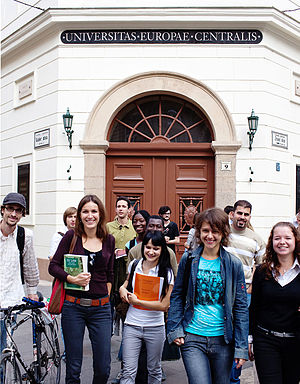
The Central European University (CEU) is a graduate-level, English-language university promoting a distinctively Central European perspective. It was established in 1991 by a Hungarian philanthropist George Soros, who has provided an endowment of US$880 million, making the university one of the wealthiest in Europe . CEU has more than 1500 students from 100 countries and 300 faculty members from more than 30 countries.
Regional exchange program
Central European Exchange Program for University Studies (CEEPUS) is an international exchange program for students and teachers teaching or studying in participating countries. Its current members include:
 Albania
Albania Austria
Austria Bosnia and Herzegovina
Bosnia and Herzegovina Bulgaria
Bulgaria Croatia
Croatia Czech Republic
Czech Republic Hungary
Hungary Kosovo
Kosovo Macedonia
Macedonia Moldova
Moldova Montenegro
Montenegro Poland
Poland Romania
Romania Serbia
Serbia Slovakia
Slovakia Slovenia
Slovenia
Sport
Main article: Sport in EuropeThere is a number of specifically Central European Sport events and leagues. They include:
- Central European Tour Miskolc GP (Hungary)*
- Central European Tour Budapest GP (Hungary)
- Central Europe Rally (Romania and Hungary)*
- Central European Football League (Austria, Croatia, Hungary, Serbia, Slovakia, Slovenia and Turkey)
- Central European International Cup (Austria, Czechoslovakia, Hungary, Italy, Poland, Switzerland and Yugoslavia; 1927-1960)
The most popular sports in Central Europe are football and winter sports.
Culture
Main article: Culture of EuropeLiterature
Central European literature topics include everyday life, such as struggle with social issues (Henryk Sienkiewicz, Gerhart Hauptmann, Władysław Reymont, Thomas Mann) bureaucracy and absurd(Franz Kafka, Witold Gombrowicz), as well as the region's past: World War I (Carl Spitteler, Jaroslav Hašek, Robert Musil), World War II, especially the Holocaust(Heinrich Böll, Leon Kruczkowski, Isaac Bashevis Singer, Tadeusz Borowski), anti-Communism (Jaroslav Seifert, Czesław Miłosz)(Imre Kertész, Elfriede Jelinek), expulsions (Günter Grass) and life under the communism (Herta Müller, Wisława Szymborska).
Cuisine
Main articles: Central European cuisine and European cuisineCentral European cuisine has evolved through centuries due to social and political change. Most countries share many dishes. The most popular dishes typical to Central Europe are sausages and cheeses, where the earliest evidence of cheese-making in the archaeological record dates back to 5,500 BCE (Kujawy, Poland). Other foods widely associated with Central Europe are goulash and beer. List of countries by beer consumption per capita is led by the Czech Republic, followed by Germany and Austria. Poland comes 9th, Slovenia 12th, Croatia 15th and Romania 16th.
Art and Architecture
Main articles: Art of Europe and Architecture of EuropeCentral European architecture has been shaped by major European styles including but not limited to: Brick Gothic, Rococo, Secession (art) and Modern architecture. Four Central European countries are amongst countries with highers number of World Heritage Sites:
 Germany (position 4th=, 38 sites)
Germany (position 4th=, 38 sites) Poland (position 17th=, 15 sites)
Poland (position 17th=, 15 sites) Czech Republic (position 19th, 12 sites)
Czech Republic (position 19th, 12 sites) Switzerland (position 20th=, 11 sites)
Switzerland (position 20th=, 11 sites)
Beliefs
Main article: Religion in EuropeCentral Europe has been a centre of Protestantism in the past, however it has been mostly eradicated by the Counterreformation. Central European countries are mostly Catholic (Austria, Croatia, Liechtenstein, Luxembourg, Slovakia, Slovenia), historically Protestant, later Catholic (the Czech Republic), Protestant or mixed Catholic and Protestant (Germany, Hungary and Switzerland). Serbia is mostly Orthodox and Romania is mostly Orthodox with significant Protestant and Catholic. In some of these countries, there is a number of atheists, undeclared and non-religious people: the Czech Republic (non-religious 34.2% and undeclared 45.2%) Germany (non-religious 38%), Slovenia (atheist 30.2%), Luxembourg (25% non-religious), Switzerland (20.1%), Hungary (27.2% undeclared, 16.7% "non-religious" and 1.5% atheists), Slovakia (atheists and non-religious 13.4%, "not specified" 10.6%) Austria (19.7% of "other or none"), Liechtenstein (10.6% with no religion), Serbia (theist 2.2% and undeclared 3.1%) and Poland (3% of non-believers/agnostics and 1% of undeclared), Croatia (4%).
Geography
Main article: Geography of Europe
According to various calculations of the midpoint of Europe, Central Europe is geographically located west to the midpoint of the continent. Nevertheless, the International Geographical Union during the conference in Prague in 1994 has established Central European countries as:
Central European Flora region

The Central European Flora region stretches from Central France (Massif Central) to Central Romania (Carpathians) and Southern Scandinavia.
Physical geography
Between the Alps and the Baltics
Geography strongly defines Central Europe's borders with its neighbouring regions to the North and South, namely Northern Europe (or Scandinavia) across the Baltic Sea, the Apennine peninsula (or Italy) across the Alps and the Balkan peninsula across the Soča-Krka-Sava-Danube line. The borders to Western Europe and Eastern Europe are geographically less defined and for this reason the cultural and historical boundaries migrate more easily West-East than South-North. The Rhine river which runs South-North through Western Germany is an exception.

Pannonian Plain and Carpathian Mountains

Southwards, the Pannonian Plain is bounded by the rivers Sava and Danube- and their respective floodplains. The Pannonian Plain stretches over the following countries: Austria, Croatia, Hungary, Romania, Serbia, Slovakia and Slovenia, and touches borders of Bosnia and Herzegovina (Republika Srpska) and Ukraine ("peri- Pannonian states").
Dinaric Alps
As southeastern division of the Eastern Alps, the Dinaric Alps extend for 650 kilometres along the coast of the Adriatic Sea (northwest-southeast), from the Julian Alps in the northwest down to the Šar-Korab massif, north-south. According to the Freie Universitaet Berlin this mountain chain is classified as South Central European.
Politics
Main article: Politics of EuropeOrganisations
Central Europe is a birthplace of regional political organisations:
- Visegrad group
- Centrope
- Central European Initiative
- Central European Free Trade Agreement
- Middleeuropean Initiative
-
 Central European Initiative
Central European Initiative
-
 Visegrád Group
Visegrád Group
-
CEFTA founding states
-
CEFTA members in 2003, before joining the EU
-
 Current CEFTA members
Current CEFTA members
Democracy Index
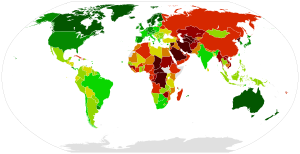
Full democracies:
9.00-10.00 8.00-8.99 Flawed democracies:
7.00-7.99 6.00-6.99 Hybrid regimes:
5.00-5.99 4.00-4.99 Authoritarian regimes:
3.00-3.99 2.00-2.99 0.00-1.99 Insufficient information, no rating:
Central Europe is a home to some of world's oldest democracies. However, most of them have been impacted by totalitarian rule, particularly Nazism (Germany, Austria, other occupied countries) and Communism, most of Central Europe have been occupied and later allied with the USSR, often against their will through forged referendum (e.g. Polish people's referendum, 1946) or force. Nevertheless, these experiences have been dealt in most of them. Most of Central European countries score very highly in the Democracy Index:
 Switzerland (position )
Switzerland (position ) Luxembourg (position 11)
Luxembourg (position 11) Austria (position 12)
Austria (position 12) Germany (position 14)
Germany (position 14) Czech Republic (position 17)
Czech Republic (position 17) Slovenia (position 28)
Slovenia (position 28) Slovakia (position 40)
Slovakia (position 40) Poland (position 44)
Poland (position 44) Hungary (position 49)
Hungary (position 49) Croatia (position 50)
Croatia (position 50) Romania (position 59)
Romania (position 59) Serbia (position 66)
Serbia (position 66) Liechtenstein (not listed)
Liechtenstein (not listed) Luxembourg (not listed)
Luxembourg (not listed)
Global Peace Index

In spite of turbulent history, Central Europe is currently one of world's safest regions. Most Central European countries are in top 20%:
 Austria (position 4)
Austria (position 4) Switzerland (position 5)
Switzerland (position 5) Slovenia (position 13)
Slovenia (position 13) Czech Republic (position 14)
Czech Republic (position 14) Germany (position 15)
Germany (position 15) Hungary (position 23)
Hungary (position 23) Poland (position 25)
Poland (position 25) Croatia (position 28)
Croatia (position 28) Romania (position 30)
Romania (position 30) Slovakia (position 33)
Slovakia (position 33) Serbia (position 62)
Serbia (position 62) Liechtenstein (not listed)
Liechtenstein (not listed) Luxembourg (not listed)
Luxembourg (not listed)
Media
Main article: MediaFreedom of Press Index

| Very serious situation Difficult situation Noticeable problems | Satisfactory situation Good situation Not classified / No data |
Central European media are considered as free. Some of the top scoring countries are in Central Europe:
 Luxembourg (position 4)
Luxembourg (position 4) Liechtenstein (position 7)
Liechtenstein (position 7) Austria (position 12)
Austria (position 12) Switzerland (position 12)
Switzerland (position 12) Czech Republic (position 16)
Czech Republic (position 16) Germany (position 17)
Germany (position 17) Poland (position 22)
Poland (position 22) Slovakia (position 23)
Slovakia (position 23) Slovenia (position 35)
Slovenia (position 35) Romania (position 42)
Romania (position 42) Hungary (position 56)
Hungary (position 56) Serbia (position 63)
Serbia (position 63) Croatia (position 64)
Croatia (position 64)
Central European Time
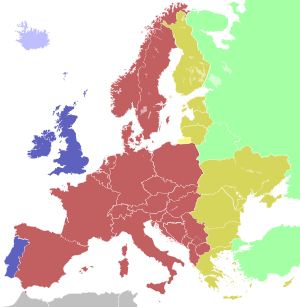
The time zone used in most parts of the European Union, is a standard time which is 1 hour ahead of Coordinated Universal Time. It is commonly called Central European Time, because it has been first adopted in central Europe (by year):
 Hungary (1890)
Hungary (1890) Slovakia (1890)
Slovakia (1890) Czech Republic (1891)
Czech Republic (1891) Germany (1893)
Germany (1893) Austria (1893)
Austria (1893) Poland (1893*)
Poland (1893*) Switzerland (1894)
Switzerland (1894) Liechtenstein (1894)
Liechtenstein (1894) Luxembourg (1904-1918, 1940-onwards)
Luxembourg (1904-1918, 1940-onwards) Serbia (at least since 1983)
Serbia (at least since 1983)
Demographics
Main article: Demographics of Europe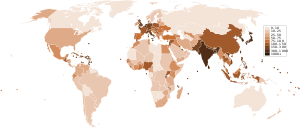
Central Europe is one of continent’s most populous regions. It includes countries of varied sizes, ranging from tiny Liechtenstein to Germany, the largest European country by population (that is entirely placed in Europe). Demographic figures for countries entirely located within notion of Central Europe (“the core countries”) number around 165 million people, out of which around 82 million are residents of Germany. Other populations include: Poland with around 39 million residents, Czech republic at 10.5 million, Hungary - 10 million, Austria with 8.5 million, Switzerland with its 8 million inhabitants, Slovakia at 5.5 million, Croatia at 4,3 million, Slovenia at 2 million and Liechtenstein at 0,03 million.
If the countries which are occasionally included in Central Europe were counted in, partially or in whole - Romania (7 - 19 million people), Serbia (3,6 – 7 million), Lithuania (3.5 million), Latvia (2.5 million), Estonia (1.5 million) – it would contribute to the rise of between 20 - 37.5 million, depending on whether regional or integral approach was used. If smaller, western and eastern historical parts of Central Europe would be included in the demographic corpus, further 20 million people of different nationalities would also be added in the overall count, it would surpass the 200 million people figure.
-
 Central Europe according to Peter J. Katzenstein (1997)
Central Europe according to Peter J. Katzenstein (1997)
The Visegrád Group countries are referred to as Central Europe in the book countries for which there's no precise, uncontestable way to decide whether they are parts of Central Europe or not -
 According to The Economist and Ronald Tiersky a strict definition of Central Europe means the Visegrád Group
According to The Economist and Ronald Tiersky a strict definition of Central Europe means the Visegrád Group
-
Map of Central Europe, according to Lonnie R. Johnson (2011) Countries usually considered Central European (citing the World Bank and the OECD) Countries considered to be Central European only in the broader sense of the term.
-
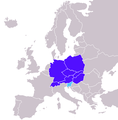 Central European countries in Encarta Encyclopedia (2009)
Central European countries in Encarta Encyclopedia (2009)
Central European countries Slovenia in "south central Europe" -
The Central European Countries according to Meyers Grosses Taschenlexikon (1999):
Countries usually considered Central European Central European countries in the broader sense of the term Countries occasionally considered to be Central European -
Middle Europe (Brockhaus Enzyklopädie, 1998))
-
 Central Europe according to Swansea University professors Robert Bideleux and Ian Jeffries (1998)
Central Europe according to Swansea University professors Robert Bideleux and Ian Jeffries (1998)
-
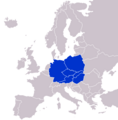 The map of Central Europe according to the University of Texas at Austin and the University of North Carolina at Charlotte
The map of Central Europe according to the University of Texas at Austin and the University of North Carolina at Charlotte
The concept
Middle Ages
Main article: Middle AgesAs elements of unity for Western and Central Europe were considered the Roman Catholicism and Latin. Eastern Europe that remained Orthodox Christian, was the area of Byzantine cultural influence, and after the schism will develop cultural unity and protection against the Catholic and Protestant (Western) world, within the framework of Slavonic language and the Cyrillic alphabet.
According to Hungarian historian Jenő Szűcs, foundations of Central European history at the first millennium were in close connection with Western European development. He explained that between the 11th and 15th centuries not only Christianization and its cultural consequences were implemented, but well-defined social features emerged in Central Europe based on Western characteristics. The keyword of Western social development after millennium was the spread of liberties and autonomies in Western Europe. These phenomena appeared in the middle of the 13th century in Central European countries. There were self-governments of towns, counties and parliaments.
In 1335 under the rule of the King Charles I of Hungary, the castle of Visegrád, the seat of the Hungarian monarchs was the scene of the royal summit of the Kings of Poland, Bohemia and Hungary. They agreed to cooperate closely in the field of politics and commerce, inspiring their late successors to launch a successful Central European initiative.
In the Middle Ages, countries in Central Europe adopted Magdeburg rights.
Before World War I
Before 1870, the industrialization that had developed in Western and Central Europe and the United States did not extend in any significant way to the rest of the world. Even in Eastern Europe, industrialization lagged far behind. Russia, for example, remained largely rural and agricultural, and its autocratic rulers kept the peasants in serfdom.
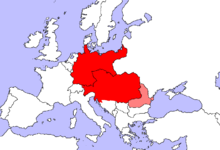
The concept of Central Europe was already known at the beginning of the 19th century, but its real life began in the 20th century and immediately became an object of intensive interest. However, the very first concept mixed science, politics and economy – it was strictly connected with intensively growing German economy and its aspirations to dominate a part of European continent called Mitteleuropa. The German term denoting Central Europe was so fashionable that other languages started referring to it when indicating territories from Rhine to Vistula, or even Dnieper, and from the Baltic Sea to the Balkans. An example of that-time vision of Central Europe may be seen in J. Partsch’s book of 1903.
On 21 January 1904 – Mitteleuropäischer Wirtschaftsverein (Central European Economic Association) was established in Berlin with economic integration of Germany and Austria–Hungary (with eventual extension to Switzerland, Belgium and the Netherlands) as its main aim. Another time, the term Central Europe became connected to the German plans of political, economic and cultural domination. The “bible” of the concept was Friedrich Naumann’s book Mitteleuropa in which he called for an economic federation to be established after the war. Naumann's idea was that the federation would have at its center Germany and the Austro-Hungarian Empire but would also include all European nations outside the Anglo-French alliance, on one side, and Russia, on the other. The concept failed after the German defeat in World War I and the dissolution of Austria–Hungary. The revival of the idea may be observed during the Hitler era.
Interwar period

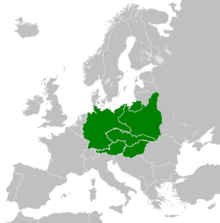
According to Emmanuel de Martonne, in 1927 the Central European countries included: Germany, Switzerland, Austria, Poland, Czechoslovakia, Hungary and Romania. Italy and Yugoslavia are not considered by the author to be Central European because they are located mostly outside Central Europe. The author use both Human and Physical Geographical features to define Central Europe.
The interwar period (1918–1939) brought new geopolitical system and economic and political problems, and the concept of Central Europe took a different character. The centre of interest was moved to its eastern part – the countries that have (re)appeared on the map of Europe: Poland, Hungary and Czechoslovakia. Central Europe ceased to be the area of German aspiration to lead or dominate and became a territory of various integration movements aiming at resolving political, economic and national problems of "new" states, being a way to face German and Soviet pressures. However, the conflict of interests was too big and neither Little Entente nor Intermarium (Międzymorze) ideas succeeded.
The interwar period brought new elements to the concept of Central Europe. Before World War I, it embraced mainly German states (Germany, Austria), non-German territories being an area of intended German penetration and domination – German leadership position was to be the natural result of economic dominance. After the war, the Eastern part of Central Europe was placed at the centre of the concept. At that time the scientists took interest in the idea: the International Historical Congress in Brussels in 1923 was committed to Central Europe, and the 1933 Congress continued the discussions.

Hungarian scholar Magda Adam wrote in her study Versailles System and Central Europe (2006): "Today we know that the bane of Central Europe was the Little Entente, military alliance of Czechoslovakia, Romania and Kingdom of Serbs, Croats and Slovenes (later Yugoslavia), created in 1921 not for Central Europe's cooperation nor to fight German expansion, but in a wrong perceived notion that a completely powerless Hungary must be kept down".
The avant-garde movements of Central Europe were an essential part of modernism’s evolution, reaching its peak throughout the continent during the 1920s. The Sourcebook of Central European avantgards (Los Angeles County Museum of Art) contains primary documents of the avant-gardes in Austria, Czechoslovakia, Germany, Hungary, Poland, Romania, and Yugoslavia from 1910 to 1930. The manifestos and magazines of Western European radical art circles are well known to Western scholars and are being taught at primary universities of their kind in the western world.
Central Europe behind the Iron Curtain
Following World War II, large parts of Europe that were culturally and historically Western became part of the Eastern bloc. Czech author Milan Kundera (emigrant to France) thus wrote in 1984 about the "Tragedy of Central Europe" in the New York Review of Books. Consequently, the English term Central Europe was increasingly applied only to the westernmost former Warsaw Pact countries (East Germany, Poland, Czechoslovakia, Hungary) to specify them as communist states that were culturally tied to Western Europe. This usage continued after the end of the Warsaw Pact when these countries started to undergo transition.
The post-World War II period brought blocking of the research on Central Europe in the Eastern Bloc countries, as its every result proved the dissimilarity of Central Europe, which was inconsistent with the Stalinist doctrine. On the other hand, the topic became popular in Western Europe and the United States, much of the research being carried out by immigrants from Central Europe. At the end of the communism, publicists and historians in Central Europe, especially anti-communist opposition, came back to their research.
According to Meyers Enzyklopädisches Lexikon, Central Europe is a part of Europe composed by the surface of the Netherlands, Belgium, Luxembourg, Germany, Poland, Switzerland, Austria, Czechoslovakia, Hungary and Romania, northern marginal regions of Italy and Yugoslavia (northern states- Slovenia, Croatia and Serbia) as well as northeastern France.
-
Central Europe, as defined by E. Schenk (1950)
-
Central Europe, according to Alice F. A. Mutton in Central Europe. A Regional and Human Geography (1961)
-
Central Europe according to Meyers Enzyklopaedisches Lexikon (1980)
Mitteleuropa, the German term
| This section may contain information not important or relevant to the article's subject. Please help improve this section. (April 2012) (Learn how and when to remove this message) |
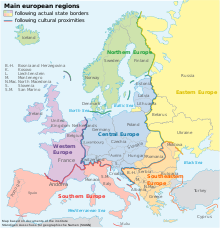
The German term Mitteleuropa (or alternatively its literal translation into English, Middle Europe) is an ambiguous German concept. It is sometimes used in English to refer to an area somewhat larger than most conceptions of 'Central Europe'; it refers to territories under German(ic)-Slavic cultural hegemony until World War I (encompassing Austria–Hungary and Germany in their pre-war formations but usually excluding the Baltic countries north of East Prussia). According to Fritz Fischer Mitteleuropa was a scheme in the era of the Reich of 1871–1918 by which the old imperial elites had allegedly sought to build a system of German economic, military and political domination from the northern seas to the Near East and from the Low Countries through the steppes of Russia to the Caucasus. Later on, professor Fritz Epstein argued the threat of a Slavic "Drang nach Westen" (Western expansion) had been a major factor in the emergence of a Mitteleuropa ideology before the Reich of 1871 ever came into being.
In Germany the connotation is also sometimes linked to the pre-war German provinces east of the Oder-Neisse line which were lost as the result of World War II, annexed by People's Republic of Poland and the Soviet Union, and ethnically cleansed of Germans by communist authorities and forces (see expulsion of Germans after World War II) due to Yalta Conference and Potsdam Conference decisions. In this view Bohemia and Moravia, with its dual Western Slavic and Germanic heritage, combined with the historic element of the "Sudetenland", is a core region illustrating the problems and features of the entire Central European region.
The term Mitteleuropa conjures up negative historical associations, although the Germans have not played an exclusively negative role in the region. Most Central European Jews embraced the enlightened German humanistic culture of the 19th century. German-speaking Jews from turn of the 20th century Vienna, Budapest and Prague became representatives of what many consider to be Central European culture at its best, though the Nazi version of "Mitteleuropa" destroyed this kind of culture. Some German speakers are sensitive enough to the pejorative connotations of the term Mitteleuropa to use Zentraleuropa instead. Adolf Hitler was obsessed by the idea of Lebensraum and many non-German Central Europeans identify Mitteleuropa with the instruments he employed to acquire it: war, deportations, genocide.
Current views on Central Europe
Rather than a physical entity, Central Europe is a concept of shared history which contrasts with that of the surrounding regions. The issue of how to name and define the Central European region is subject to debates. Very often, the definition depends on the nationality and historical perspective of its author.
Main propositions, gathered by Jerzy Kłoczowski, include:
- West-Central and East-Central Europe – this conception, presented in 1950, distinguishes two regions in Central Europe: German West-Centre, with imperial tradition of the Reich, and the East-Centre covered by variety of nations from Finland to Greece, placed between great empires of Scandinavia, Germany, Italy and the Soviet Union.
- Central Europe as the area of cultural heritage of the Polish-Lithuanian Commonwealth – Ukrainian, Belarusian and Lithuanian historians, in cooperation (since 1990) with Polish historians, insist on the importance of the concept.
- Central Europe as a region connected to the Western civilisation for a very long time, including countries like the Polish-Lithuanian Commonwealth, Holy Roman Empire, later German Empire and the Habsburg Monarchy, the Kingdom of Hungary and the Crown of Bohemia. Central Europe understood in this way borders on Russia and South-Eastern Europe, but the exact frontier of the region is difficult to determine.
- Central Europe as the area of cultural heritage of the Habsburg Empire (later Austria-Hungary) – a concept which is popular in regions along the Danube River.
- A concept underlining the links connecting Ukraine and Belarus with Russia and treating the Russian Empire together with the whole Slavic Orthodox population as one entity – this position is taken by the Russian historiography.
- A concept putting an accent on the links with the West, especially from the 19th century and the grand period of liberation and formation of Nation-states – this idea is represented by in the South-Eastern states, which prefer the enlarged concept of the “East Centre” expressing their links with the Western culture.
According to Ronald Tiersky, the 1991 summit held in Visegrád, Hungary and attended by the Polish, Hungarian and Czechoslovak presidents was hailed at the time as a major breakthrough in Central European cooperation, but the Visegrád Group became a vehicle for coordinating Central Europe's road to the European Union, while development of closer ties within the region languished.
Peter J. Katzenstein described Central Europe as a way station in a Europeanization process that marks the transformation process of the Visegrád Group countries in different, though comparable ways. According to him, in Germany's contemporary public discourse "Central European identity" refers to the civilizational divide between Roman Catholicism and Eastern Orthodoxy. He says there's no precise, uncontestable way to decide whether the Baltic states, Serbia, Croatia, Slovenia, Romania, and Bulgaria are parts of Central Europe or not.
Lonnie R. Johnson points out criteria to distinguish Central Europe from Western, Eastern and Southeast Europe:
- One criterion for defining Central Europe is the frontiers of medieval empires and kingdoms that largely correspond to the religious frontiers between the Roman Catholic West and the Orthodox East. The pagans of Central Europe were converted to Roman Catholicism while in Southeastern and Eastern Europe they were brought into the fold of the Eastern Orthodox Church.
- Multinational empires were a characteristic of Central Europe. Hungary and Poland, small and medium-size states today, were empires during their early histories. The historical Kingdom of Hungary was until 1918 three times larger than Hungary is today, while Poland was the largest state in Europe in the 16th century. Both these kingdoms housed a wide variety of different peoples.
He also thinks that Central Europe is a dynamical historical concept, not a static spatial one. For example, Lithuania, a fair share of Belarus and western Ukraine are in Eastern Europe today, but 250 years ago they were in Polish-Lithuanian Commonwealth.
Johnson's study on Central Europe received acclaim and positive reviews in the scientific community. However, according to Romanian researcher Maria Bucur this very ambitious project suffers from the weaknesses imposed by its scope (almost 1600 years of history).
The Columbia Encyclopedia defines Central Europe as: Germany, Switzerland, Liechtenstein, Austria, Poland, Czechia, Slovakia, and Hungary. The World Factbook Encyclopedia Britannica and Brockhaus Enzyklopädie use the same definition adding Slovenia too. Encarta Encyclopedia does not clearly define the region, but places the same countries into Central Europe in its individual articles on countries, adding Slovenia in "south central Europe". While the United Nations Statistical Division doesn't acknowledge a regional division of Central Europe, identifying four geographic region of Europe (North, South, East and West)., the United Nations Group of Experts on Geographical Names does recognise Central Europe and in 2006 it included Central Europe with an extensive description in its proposed "Subdivision of Europe into Larger Regions by Cultural Criteria ".
The German Encyclopaedia Meyers Grosses Taschenlexikon (Template:Lang-en), 1999, defines Central Europe as the central part of Europe with no precise borders to the East and West. The term is mostly used to denominate the territory between the Schelde to Vistula and from the Danube to the Moravian Gate. Usually the countries considered to be Central European are Germany, Switzerland, Austria, Poland, Czechia, Slovakia, Slovenia, Croatia, Hungary; in the broader sense Romania too, northern Serbia, occasionally also the Netherlands, Belgium and Luxembourg.
The concept of Central Europe, and that of a common identity, is somewhat elusive and contested. However, some scholars assert that a distinct "Central European culture, as controversial and debated the notion may be, exists." This viewpoint is based on "similarities emanating from historical, social and cultural characteristics", and it is identified as having been "one of the world's richest sources of creative talent" between the 17th and 20th centuries. Cross Currents: A Yearbook of Central European Culture characterizes Central Europe "as an abandoned West or a place where East and West collide". Germany's Permanent Committee on Geographical Names defines Central Europe both as a distinct cultural area and a political region. George Schöpflin and others argue that Central Europe is defined by being "a part of Western Christianity", and Samuel P. Huntington places the region firmly within Western culture.
See also
- Central and Eastern Europe
- Central European Initiative
- Central European Time (CET)
- Central European University
- East-Central Europe
- Geographical centre of Europe
- Life zones of central Europe
- Międzymorze (Intermarum)
- Mitteleuropa
References
- ^ "The World Factbook: Field listing – Location". The World Factbook. Central Intelligence Agency. 2009. Retrieved 3 May 2009.
- ^ Lonnie Johnson, Central Europe: Enemies, Neighbors, Friends, Oxford University Pres
- "Central Europe — The future of the Visegrad group". The Economist. 14 April 2005. Retrieved 7 March 2009.
- "Regions, Regionalism, Eastern Europe by Steven Cassedy". New Dictionary of the History of Ideas, Charles Scribner's Sons. 2005. Retrieved 31 January 2010.
- Lecture 14: The Origins of the Cold War. Historyguide.org. Retrieved on 2011-10-29.
- ^ Agh 1998, pp. 2–8 harvnb error: no target: CITEREFAgh1998 (help)
- "Central European Identity in Politics — Jiří Pehe" (in Czech). Conference on Central European Identity, Central European Foundation, Bratislava. 2002. Retrieved 31 January 2010.
- "Europe of Cultures: Cultural Identity of Central Europe". Europe House Zagreb, Culturelink Network/IRMO. 24 November 1996. Retrieved 31 January 2010.
- ^ Comparative Central European culture. Purdue University Press. 2002. ISBN 9781557532404. Retrieved 31 January 2010. Cite error: The named reference "books.google.com" was defined multiple times with different content (see the help page).
- ^ "An Introduction to Central Europe: History, Culture, and Politics – Preparatory Course for Study Abroad Undergraduate Students at CEU" (PDF). Central European University. Budapest. Fall 2006.
- ^ Ben Koschalka – content, Monika Lasota – design and coding. "To Be (or Not To Be) Central European: 20th Century Central and Eastern European Literature". Centre for European Studies of the Jagiellonian University. Retrieved 31 January 2010.
- ^ "Ten Untaught Lessons about Central Europe-Charles Ingrao". HABSBURG Occasional Papers, No. 1. 1996. Retrieved 31 January 2010.
- ^ "Introduction to the electronic version of Cross Currents". Scholarly Publishing Office of the University of Michigan Library. Retrieved 31 January 2010.
- ^ "StAGN-Empfehlung zur Großgliederung Europas". StAGN.de. Retrieved 31 January 2011.
- ^ "A Subdivision of Europe into Larger Regions by Cultural Criteria". Retrieved 15 January 2011.
- ^ History of the literary cultures of East-Central Europe: junctures and disjunctures in the 19th and 20th centuries, Volume 2
- ^ When identity becomes an alibi (Institut Ramon Llull)
- "The Mice that Roared: Central Europe Is Reshaping Global Politics". Spiegel.de. 26 February 2006. Retrieved 31 January 2010.
- "Which regions are covered?". European Regional Development Fund. Retrieved 31 January 2010.
- ^ 2013 Human Development Index. (PDF) . Retrieved on 2014-01-24.
- "For the Record – The Washington Post – HighBeam Research". Highbeam.com. 3 May 1990. Retrieved 31 January 2010.
- ^ "From Visegrad to Mitteleuropa". The Economist. 14 April 2005.
- "Borders in Central Europe: From Conflict to Cooperation". Geopolitics of European Union Enlargement: The Fortress Empire. Routledge. 2007. p. 165. ISBN 978-1-134-30132-4.
{{cite book}}: Unknown parameter|authors=ignored (help) - ^ "Borders in Central Europe: From Conflict to Cooperation". Geopolitics of European Union Enlargement: The Fortress Empire. Routledge. 2007. p. 165. ISBN 978-1-134-30132-4.
{{cite book}}: Unknown parameter|authors=ignored (help) - ^ Columbia Electronic Encyclopedia
- Federal Agency for Civic Education Germany (german)
- UNHCR - Croatia
- Florida Stats University - Croatian Program - Security & Cooperation in South Eastern Europe
- European Commission - Development programmes - Operational Programme 'South East Europe (SEE)'
- Andrew Geddes,Charles Lees,Andrew Taylor : "The European Union and South East Europe: The Dynamics of Europeanization and multilevel goverance", 2013, Routledge
- Klaus Liebscher, Josef Christl, Peter Mooslechner, Doris Ritzberger-Grünwald : "European Economic Integration and South-East Europe: Challenges and Prospects", 2005, Edward Elgar Publishing Limited
- https://www.google.com/search?q=central+europe+romania&btnG=Search+Books&tbm=bks&tbo=1#hl=en&tbo=1&tbm=bks&sclient=psy-ab&q=%22ROMANIA+IS+IN+THE+SOUTHEASTERN+PART+OF+CENTRAL+EUROPE%22&oq=%22ROMANIA+IS+IN+THE+SOUTHEASTERN+PART+OF+CENTRAL+EUROPE%22&gs_l=serp.3...16472.18398.1.18584.3.3.0.0.0.0.78.200.3.3.0...0.0...1c.1.wbGIt7ADCVY&psj=1&bav=on.2,or.r_gc.r_pw.r_cp.r_qf.&fp=6713caafbf43bae1&bpcl=37189454&biw=930&bih=593
- United States. Foreign Broadcast Information Service Daily report: East Europe
- Council of Europe. Parliamentary Assembly Official Report of Debates
- ^ "Vlada Autonomne Pokrajine Vojvodine – Index". Vojvodina.gov.rs. 27 January 2010. Retrieved 31 January 2010.
- ^ The Austrian Occupation of Novibazar, 1878–1909. Mtholyoke.edu. Retrieved on 2011-10-29.
- ^ http://www.conflicts.rem33.com/images/Ungarn/OESTEREICH%20ENTWICKLUNG.jpg
- Sven Tägil, Regions in Central Europe: The Legacy of History, C. Hurst & Co. Publishers, 1999, p. 191
- Klaus Peter Berger, The Creeping Codification of the New Lex Mercatoria, Kluwer Law International, 2010, p. 132
- There is no data in the Liechtenstein of economic globalization
- http://srufaculty.sru.edu/james.hughes/100/100-5/d-5-19.htm
- "GDP (Official Exchange Rate)". CIA World Factbook. Retrieved 2 June 2012.
- http://unstats.un.org/unsd/snaama/dnltransfer.asp?fID=2
- http://data.worldbank.org/indicator/NY.GDP.MKTP.PP.CD/countries/order%3Dwbapi_data_value_2012%20wbapi_data_value%20wbapi_data_value-last?order=wbapi_data_value_2012%20wbapi_data_value%20wbapi_data_value-last&sort=desc&display=default
- https://www.cia.gov/library/publications/the-world-factbook/fields/2001.html
- Based on the IMF figures. If no number was available for a country from IMF, CIA figures were used.
- National Accounts Main Aggregates Database, December 2013, United Nations Statistics Division. Accessed on 13 December 2013.
- Data refer mostly to the year 2012. "GDP per capita, PPP (current international $)", World Development Indicators database, World Bank. Database updated on 23 September 2013. Accessed on 9 October 2013.
- GDP - per capita (PPP), The World Factbook, Central Intelligence Agency. Accessed on 9 October 2013.
- http://wyborcza.biz/biznes/1,100896,15324289,Ranking_najbardziej_innowacyjnych_krajow__Zaskakujaco.html#BoxBizTxt
- http://images.businessweek.com/bloomberg/pdfs/most_innovative_countries_2014_011714.pdf
- http://www.prosperity.com/
- http://cpi.transparency.org/cpi2013/infographic/
- http://bpi.transparency.org/bpi2011/results/
- http://epp.eurostat.ec.europa.eu/statistics_explained/index.php/Inland_transport_infrastructure_at_regional_level
- http://w3.unece.org/pxweb/quickstatistics/readtable.asp?qs_id=47
- http://atlas.media.mit.edu/rankings/
- http://www3.weforum.org/docs/WEF_TravelTourismCompetitiveness_Report_2011.pdf
- http://www.tholons.com/TholonsTop100/pdf/Tholons%20Top%20100%202013_Rankings%20and%20Report%20Overview.pdf
- http://www.nytimes.com/2013/12/23/business/international/midsize-cities-in-poland-develop-as-service-hubs-for-outsourcing-industry.html?_r=0
- http://maplecroft.com/portfolio/new-analysis/2013/12/04/70-increase-countries-identified-extreme-risk-human-rights-2008-bhuman-rights-risk-atlas-2014b/
- http://www.endcorporalpunishment.org/pages/frame.html
- http://www.endcorporalpunishment.org/pages/progress/reports/poland.html
- http://www.corpun.com/rules2.htm#poland
- http://www.endcorporalpunishment.org/pages/progress/reports/liechtenstein.html
- http://www.endcorporalpunishment.org/pages/progress/reports/luxembourg.html
- http://www.endcorporalpunishment.org/pages/progress/reports/romania.html
- http://www.endcorporalpunishment.org/pages/progress/reports/austria.html
- http://www.corpun.com/desc8707.htm
- http://www.endcorporalpunishment.org/pages/progress/reports/hungary.html
- http://www.endcorporalpunishment.org/pages/progress/prohib_states.html#croatia
- http://www.endcorporalpunishment.org/pages/progress/reports/croatia.html
- http://www.endcorporalpunishment.org/pages/progress/reports/slovenia.html
- http://www.endcorporalpunishment.org/pages/progress/reports/serbia.html
- http://www.endcorporalpunishment.org/pages/progress/reports/switzerland.html
- http://www.endcorporalpunishment.org/pages/progress/reports/slovakia.html
- http://www.endcorporalpunishment.org/pages/progress/reports/czech.html
- http://ilga.org/historic/Statehomophobia/ILGA_State_Sponsored_Homophobia_2009.pdf
- illegal under the Partitions in Austria and Germany and in Russia since 1835 by a decree of the tsar Nicolas I
- http://www.ilga-europe.org/home/news/latest/idaho_2013/trans_map_index_2013
- http://www.theguardian.com/commentisfree/2013/may/17/transgender-mp-voices-heard
- http://www.transrespect-transphobia.org/en_US/tvt-project/tmm-results/march-2013.htm
- "Forced and Slave Labour in Nazi-Dominated Europe, 1933 to 1945", United States Holocaust Memorial Museum Symposium (2002)
- Dembkowski, Harry E. (1982). The union of Lublin, Polish federalism in the golden age. East European Monographs, 1982. p. 271. ISBN 978-0-88033-009-1.
- Serbian: http://serbum.com/?p=1253
- http://www.globalslaveryindex.org/
- "Trafficking in Persons Report 2013". U.S. Department of State. 2013.
- TIER 1: Countries whose governments fully comply with the Trafficking Victims Protection Act’s (TVPA) minimum standards.
- TIER 2: Countries whose governments do not fully comply with the TVPA’s minimum standards, but are making significant efforts to bring themselves into compliance with those standards.
- WomanStats Maps, Woman Stats Project.
- http://womanstats.org/CodebookCurrent.htm#TRAFF
- http://womanstats.org/substatics/Trafficking%20of%20Women_2011tif_wmlogo3.png
- http://www.forbes.com/power-women/#page:1_sort:0_direction:asc_search:
- http://time100.time.com/2013/04/18/time-100/slide/all/
- ^ http://ec.europa.eu/public_opinion/archives/ebs/ebs_386_en.pdf
- http://www.ef.co.uk/epi/
- http://www.oecd.org/pisa/keyfindings/pisa-2012-results-overview.pdf
- http://chronicle.com/article/For-President-of-Central/65338/
- http://www.ceepus.info/default.aspx?CMSPage=65
- http://chicagounbound.uchicago.edu/cgi/viewcontent.cgi?article=5029&context=journal_articles
- http://www.ceskapozice.cz/en/blog/michael-stein/non-existence-central-european-literature
- http://www.chp.cz/curriculum/readings-central-european-literature-meeting-points-diverging-lines
- http://www.nature.com/news/art-of-cheese-making-is-7-500-years-old-1.12020
- http://go.hrw.com/hrw.nd/gohrw_rls1/pKeywordResults?ST9%20Eur%20Religions%201600
- http://wps.ablongman.com/wps/media/objects/262/268312/art/figures/KISH_13_309.gif
- http://www.emersonkent.com/map_archive/europe_religion_1560.htm
- http://connection.ebscohost.com/c/articles/9411020243/international-geographical-union-regional-conference
- Wolfgang Frey and Rainer Lösch; Lehrbuch der Geobotanik. Pflanze und Vegetation in Raum und Zeit. Elsevier, Spektrum Akademischer Verlag, München 2004 ISBN 3-8274-1193-9
- Danube Facts and Figures. Bosnia and Herzegovina (April 2007) (PDF file)
- Encyclopædia Britannica. "Dinaric Alps (mountains, Europe)". Retrieved 31 January 2010.
{{cite web}}: CS1 maint: multiple names: authors list (link) - Juliane Dittrich. "Die Alpen – Höhenstufen und Vegetation – Hauptseminararbeit". GRIN. Retrieved 31 January 2010.
- https://portoncv.gov.cv/dhub/porton.por_global.open_file?p_doc_id=1034
- http://www.visionofhumanity.org/
- "Press Freedom Index 2013", Reporters Without Borders, 30 January 2013
- Since Poland was partitioned since 1922 (official adoption), the dates of introduction in Germany (1893) and Austria (1893) should be understood as de facto adoption
- Introduced during the German occupation
- ^ "Demography report 2010" (PDF). Eurostat. Retrieved 12 May 2012. Cite error: The named reference "Eurostat" was defined multiple times with different content (see the help page).
- ^ Katzenstein, p. 6
- ^ Katzenstein, p. 4
- ^ Tiersky, p. 472
- Johnson, pp. 16
- ^ Slovenia. Archived from the original on 31 October 2009. Retrieved 1 May 2009.
{{cite encyclopedia}}:|work=ignored (help); Unknown parameter|deadurl=ignored (|url-status=suggested) (help) - http://books.google.es/books?id=Vzw8CHYQobAC&pg=PA12&dq=%22Hungary,+the+Czech+Republic,+Slovakia+and+possibly+Poland,+Slovenia+and+Croatia%22&hl=ro&sa=X&ei=L9DSUv2RMqaw0QXZtIHQAg&redir_esc=y#v=onepage&q=%22Hungary%2C%20the%20Czech%20Republic%2C%20Slovakia%20and%20possibly%20Poland%2C%20Slovenia%20and%20Croatia%22&f=false
- http://reenic.utexas.edu/regions/ceneurope.html
- The shape of Europe. The spirit of unity through culture in the eve of Modern Europe.
- László Zsinka: Similarities and Differences in Polish and Hungarian History
- ^ Halman, Loek (2004). European values at the turn of the millennium. Brill Publishers. p. 120. ISBN 978-90-04-13981-7.
{{cite book}}: Unknown parameter|coauthors=ignored (|author=suggested) (help) - Jackson J. Spielvogel: Western Civilization: Alternate Volume: Since 1300. p. 618.
- Source: Geographisches Handbuch zu Andrees Handatlas, vierte Auflage, Bielefeld und Leipzig, Velhagen und Klasing, 1902.
- ^ ""Mitteleuropa" is a multi-facetted concept and difficult to handle" (PDF). Retrieved 31 January 2010.
- A. Podraza, Europa Środkowa jako region historyczny, 17th Congress of Polish Historians, Jagiellonian University 2004
- Joseph Franz Maria Partsch, Clementina Black, Halford John Mackinder, Central Europe, New York 1903
- F. Naumann, Mitteleuropa, Berlin: Reimer, 1915
- "Regions and Eastern Europe Regionalism – Central Versus Eastern Europe". Science.jrank.org. Retrieved 31 January 2010.
- , and ; Géographie universelle (1927), edited by Paul Vidal de la Blache and Lucien Gallois
- ^ Deak, I. (2006). "The Versailles System and Central Europe". The English Historical Review. CXXI (490): 338. doi:10.1093/ehr/cej100.
- "Between Worlds – The MIT Press". Mitpress.mit.edu. Retrieved 31 January 2010.
- "Kundera's article in pdf format" (PDF).
- "Central versus Eastern Europe".
- One of the main representatives was Oscar Halecki and his book The limits and divisions of European history, London and New York 1950
- A. Podraza, Europa Środkowa jako region historyczny, 17th Congress of Polish Historians, Jagiellonian University 2004
- Band 16, Bibliographisches Institut Mannheim/Wien/Zürich, Lexikon Verlag 1980
- Erich Schenk, Mitteleuropa. Düsseldorf, 1950
- ^ Johnson, p. 165
- Hayes, p. 16
- Hayes, p. 17
- Johnson, p. 6
- ^ Johnson, p. 7
- Johnson, p. 170
- Jerzy Kłoczowski, Actualité des grandes traditions de la cohabitation et du dialogue des cultures en Europe du Centre-Est, in: L'héritage historique de la Res Publica de Plusieurs Nations, Lublin 2004, pp. 29–30 ISBN 83-85854-82-7
- Oskar Halecki, The Limits and Divisions of European History, Sheed & Ward: London and New York 1950, chapter VII
- Lonnie R. Johnson "Central Europe: enemies, neighbors, friends", Oxford University Press, 1996 ISBN 0-19-538664-7
- ^ Johnson, p.4
- ^ Johnson, p. 4
- Legvold, Robert (May/June 1997). "Central Europe: Enemies, Neighbors, Friends". Foreign Affairs. Council on Foreign Relations. Retrieved 2009-05-20.
{{cite web}}: Check date values in:|date=(help) - "Selected as "Editor's Choice" of the History Book Club". Oxford University Press. Retrieved 20 May 2009.
- Bucur, Maria (June 1997). "The Myths and Memories We Teach By". Indiana University. HABSBURG. Retrieved 23 December 2011.
- "Europe". Columbia University Press. 2009.
{{cite web}}:|access-date=requires|url=(help); Missing or empty|url=(help); Unknown parameter|encyclopedia=ignored (help) - ^ UN Composition of macro geographical (continental) regions, geographical sub-regions, and selected economic and other groupings. Revised Oct. 31. 2013.
- http://unstats.un.org/unsd/geoinfo/ungegn/docs/23-gegn/wp/gegn23wp48.pdf
- http://unstats.un.org/unsd/geoinfo/ungegn/divisions.html#
- Jiri Pehe (30 April 2003). "Central European Identity in Politics" (in Czech). Conference on Central European Identity, Central European Foundation, Bratislava. Retrieved 31 January 2010.
- "Europe of Cultures: Cultural Identity of Central Europe". Europe House Zagreb, Culturelink Network/IRMO. 24 November 1996. Retrieved 31 January 2010.
Bibliography
- Ádám, Magda (2003). The Versailles System and Central Europe Variorum Collected Studies. ASHGATE. ISBN 0-86078-905-5.
- Ádám, Magda (1993). The Little Entente and Europe(1920-1929). Akadémiai Kiadó. ISBN 963-05-6420-3.
- Ágh, Attila (1998). The politics of Central Europe. SAGE. ISBN 0-7619-5032-X.
- Hayes, Bascom Barry (1994). Bismarck and Mitteleuropa. Fairleigh Dickinson University Press. ISBN 978-0-8386-3512-4.
- Johnson, Lonnie R. (1996). Central Europe: enemies, neighbors, friends. Oxford University Press. ISBN 978-0-19-510071-6.
- Katzenstein, Peter J. (1997). Mitteleuropa: Between Europe and Germany. Berghahn Books. ISBN 978-1-57181-124-0.
- O. Benson, Forgacs (2002). Between Worlds. A Sourcebook of Central European Avant-Gardes, 1910–1930. MIT Press. ISBN 978-0-262-02530-0.
- Tiersky, Ronald (2004). Europe today. Rowman & Littlefield. ISBN 978-0-7425-2805-5.
- Tötösy de Zepetnek, Steven (2002), Comparative Central European culture, Purdue University Press, ISBN 1-55753-240-0
Further reading
- Jacques Rupnik, "In Search of Central Europe: Ten Years Later", in Gardner, Hall, with Schaeffer, Elinore & Kobtzeff, Oleg, (ed.), Central and South-central Europe in Transition, Westport, Connecticut: Praeger, 2000 (translated form French by Oleg Kobtzeff)
- Article 'Mapping Central Europe' in hidden europe, 5, pp. 14–15 (November 2005)
- "Journal of East Central Europe": http://www.ece.ceu.hu
External links
- Halecki, Oscar. "BORDERLANDS OF WESTERN CIVILIZATION A History of East Central Europe" (PDF). Oscar Halecki. Retrieved 8 August 2010.
- Map of Europe
- Maps of Europe and European countries
- Central2013.eu
- Central European Economy
- UNHCR Regional representation for Central Europe
| European Union articles | |||||||||||||||||||||||
|---|---|---|---|---|---|---|---|---|---|---|---|---|---|---|---|---|---|---|---|---|---|---|---|
| History |
| ||||||||||||||||||||||
| Geography | |||||||||||||||||||||||
| Bodies |
| ||||||||||||||||||||||
| Law | |||||||||||||||||||||||
| Economy | |||||||||||||||||||||||
| Politics |
| ||||||||||||||||||||||
| Culture | |||||||||||||||||||||||
| Lists | |||||||||||||||||||||||
| Europe articles | |||||||||
|---|---|---|---|---|---|---|---|---|---|
| History |
| ||||||||
| Geography | |||||||||
| Politics |
| ||||||||
| Economy |
| ||||||||
| Society |
| ||||||||